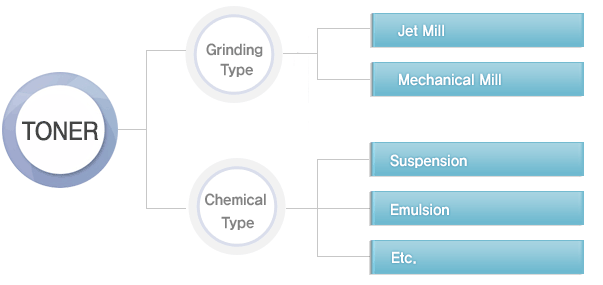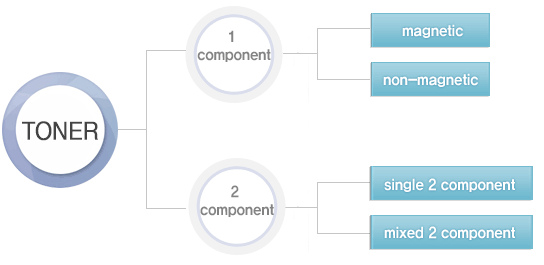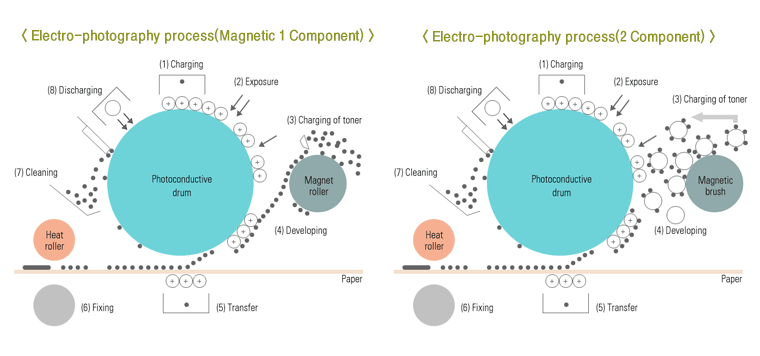Home > Products >Toner
- Introduction
- Since 1938 when Carlson invented electro-photography using tribo-electrification made everything in the office possible, starting from analoge photocopiers to digital printers, FAX, full-color photocopier and the development of complexer. Along with it, toners have progressed in line with the development of photocopiers. Toners, as inks used in copiers, are powder of about 6~15㎛ in diameter. Toners develop electrostatic latent image not visible to the eye created in visual receptors making it visible. It is also considered to be the core of electro-photography.
- Characteristics of toners
- * Focused on average particle diameter of 8 ㎛, it has consistent size distribution and is a powder with high flow-ability.
* Its main components comprise of resin, magnetite, charge control agent, pigment, wax and others, and its color, characteristics and heating traits change according to the composition
- Classification according to the manufacturing method of the toner

- Classification according to the developing method of the toner

- Basic principle of electro-photography process
-
The principle of formation of image of electronic photograph is composed of continuous system including the processes of charging the toner through triboelectrification, formation of electrostatic latent image by charging and exposure of visual receptor to light and developing visible image on top of the electrostatic latent image, followed by transcription of the image onto the paper from the visual receptor and finally settling the toner onto the paper by means of heat and pressure at the settlement section.
① Electrification: Giving electrical characteristics to toner through friction ② Light exposure: Form electrostatic latent image by exposing the visual receptor to laser light ③ Developing: Visualization by developing the toner on the latent image of the visual receptor ④ Projecting: Transfer the image from the visual receptor to paper by using toner ⑤ Fixing : Fusion melting of the projected toner on the copier paper ⑥ Cleaning : Remove the residual toner on the visual receptor
- Summary of each process
- ① Electrification
Electrification process is a process that gives electric charges on the visual receptor. As for the method of electric charges, there is a Corona method of which the ions created from the electrode that has received the high voltage adheres on the surface of the visual receptor and an electrification method of which the conductive rollers are stuck together creating electric charges on the visual receptor.② Light ExposureIf the visual receptors with light conductivity are exposed to light, the light becomes conductive, losing the electric charges and the light above the visual receptor creates electrostatic latent image. In the previous analogue method copier, the light exposure lamp is transmitted on the paper and the white part of the paper is reflected, creating electrostatic latent image through mirror and lens. Printers and facsimiles and others use laser light through controller to create images.③ DevelopingInside the developer, carrier particles with raw materials of toner, iron, ferrite and others or electric charges caused by friction by the absence of electrification such as electric charge blade receive electric charges and the toner that has received the electric charge is transferred to the roller visual receptor for developing and the image is developed by the electric charge of the visual receptor and the electrostatic.④ ProjectingThe toner developed on the visual receptor is projected on the paper by electrostatic. Here, the image is shown on the paper.⑤ FixingAs a method for projecting the toner onto the paper, heat fixing that fuses the toner by heat and the method that uses pressure to fixing have been commercialized.⑥ CleaningIn the projection process, 80~90% of the visual receptor toner is projected on the paper. If they are inserted into the light exposure as how they remain on the visual receptor, the toner blocks the light which affects the next image so because of this, there is a need to remove the toner left on the visual receptor by using rubber blade. - Developing method
-








